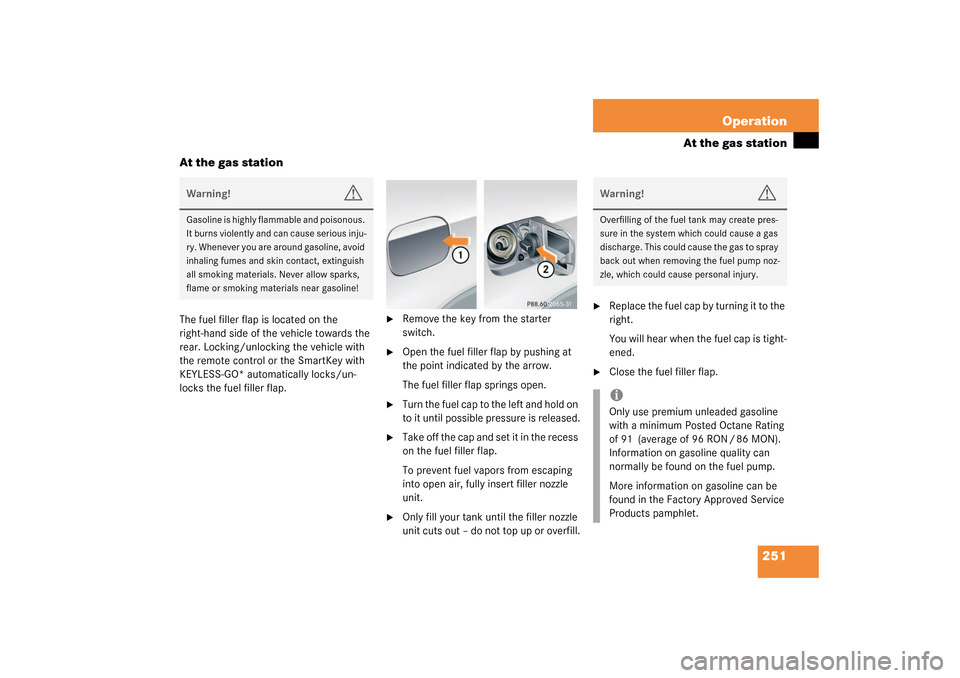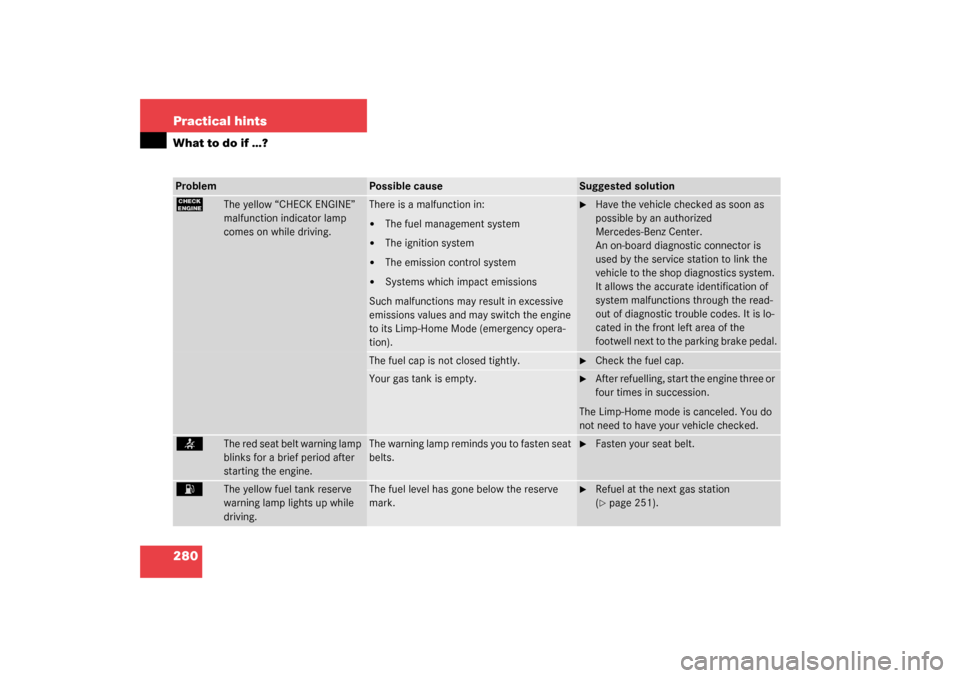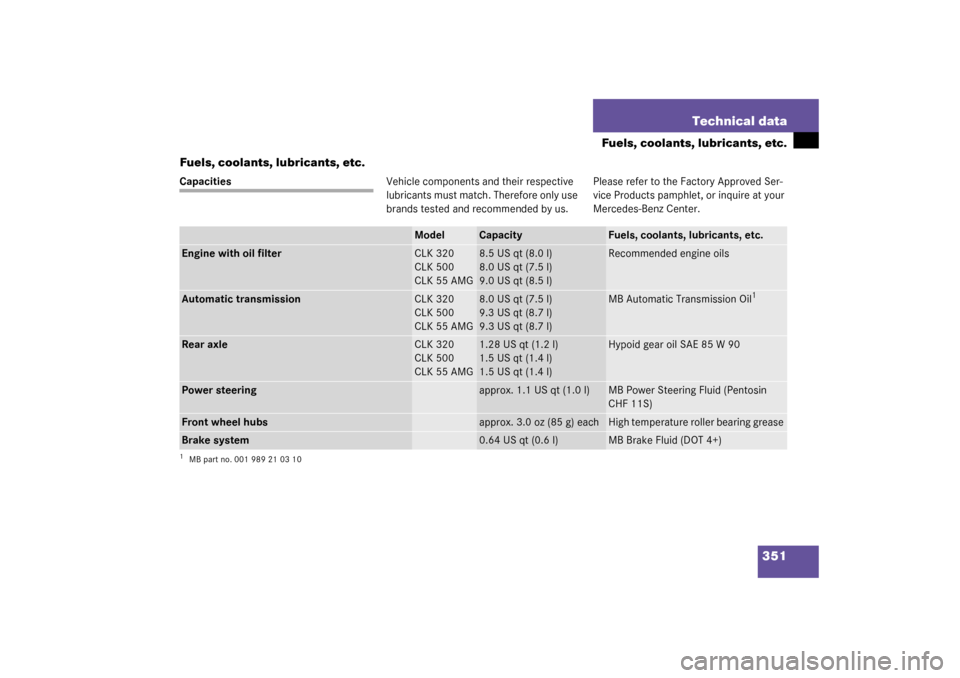Page 8 of 394
ContentsFuels, coolants, lubricants, etc. ......... 351
Capacities .................................... 351
Engine oils .................................... 353
Engine oil additives ...................... 353
Air conditioning refrigerant .......... 353
Brake fluid .................................... 353
Premium unleaded gasoline ......... 354
Fuel requirements ........................ 354
Gasoline additives ........................ 354
Coolants ....................................... 355
Windshield and
headlamp washer system ............. 357
Consumer information ....................... 358
Uniform tire quality grading.......... 358
Technical terms............................... 361Index................................................. 367
Page 251 of 394

251 Operation
At the gas station
At the gas station
The fuel filler flap is located on the
right-hand side of the vehicle towards the
rear. Locking/unlocking the vehicle with
the remote control or the SmartKey with
KEYLESS-GO* automatically locks/un-
locks the fuel filler flap.
�
Remove the key from the starter
switch.
�
Open the fuel filler flap by pushing at
the point indicated by the arrow.
The fuel filler flap springs open.
�
Turn the fuel cap to the left and hold on
to it until possible pressure is released.
�
Take off the cap and set it in the recess
on the fuel filler flap.
To prevent fuel vapors from escaping
into open air, fully insert filler nozzle
unit.
�
Only fill your tank until the filler nozzle
unit cuts out – do not top up or overfill.
�
Replace the fuel cap by turning it to the
right.
You will hear when the fuel cap is tight-
ened.
�
Close the fuel filler flap.
Warning!
G
Gasoline is highly flammable and poisonous.
It burns violently and can cause serious inju-
ry. Whenever you are around gasoline, avoid
inhaling fumes and skin contact, extinguish
all smoking materials. Never allow sparks,
flame or smoking materials near gasoline!
Warning!
G
Overfilling of the fuel tank may create pres-
sure in the system which could cause a gas
discharge. This could cause the gas to spray
back out when removing the fuel pump noz-
zle, which could cause personal injury.iOnly use premium unleaded gasoline
with a minimum Posted Octane Rating
of 91 (average of 96 RON / 86 MON).
Information on gasoline quality can
normally be found on the fuel pump.
More information on gasoline can be
found in the Factory Approved Service
Products pamphlet.
Page 252 of 394

252 OperationAt the gas station
Check regularly and before a long trip
1Coolant level
More information on coolant can be
found in the “Operation” section on
(
�page 256).
2Brake fluid (fuse box cover removed)
More information on brake fluid can be
found in the “Technical data” section
on (�page 353).
3Windshield washer and headlamp
cleaning system
More information on refilling the reser-
voir can be found in the “Operation”
section on (
�page 259).Engine oil level
More information on engine oil can be
found in the “Operation” section on
(
�page 254).
Vehicle lighting
Check function and cleanliness.More infor-
mation on replacing light bulbs can be
found in the “Practical hints” section on
(�page 316).
Tire inflation pressure
More information on tire inflate pressure
can be found in the “Operation” section on
(�page 262).
Opening hood see (
�page 253).
Removing fuse box cover see
(
�page 337).
Exterior lamp switch see (
�page 105)
iLeaving the engine running and the fuel
cap open can cause the
?
lamp to
illuminate.
More information can be found in the
“Practical hints” section (
�page 280).
Page 262 of 394

262 OperationTires and wheelsChecking tire inflation pressure
Correct the tire pressure only when tires
are cold.
Regularly check your tire pressure at inter-
vals of no more than 14 days.
If the tires are warm you should only cor-
rect the tire pressure if it is too low for cur-
rent operating conditions.
A table on the fuel filler flap lists the spec-
ified tire inflation pressures for warm and
cold tires as well as for various operating
conditions.Tire pressure changes by approximately
1.5 psi (0.1 bar) per 18°F (10°C) of air
temperature change. Keep this in mind
when checking tire pressure where the
temperature is different from the outside
temperature.
Tire temperature and tire pressure are also
increased while driving, depending on the
driving speed and the tire load.Check the spare tire periodically for condi-
tion and inflation. Spare tires will age and
become worn over time even if never used,
and thus should be inspected and replaced
when necessary.Warning!
G
If the tire pressure repeatedly drops�
check the tires for punctures from for-
eign objects
�
check to see whether air is leaking from
the valves or from around the rim
iThe pressures listed for light loads are
minimum values offering high driving
comfort.
Increased inflation pressures listed for
heavier loads may also be used for light
loads. These higher pressures produce
favorable handling characteristics. The
ride of the vehicle, however, will be
somewhat harder. Never exceed the
max. values or inflate tires below the
min. values listed in the fuel filler flap.
Warning!
G
Follow recommended inflation pressures.
Do not overinflate tires. Overinflating tires
can result in sudden deflation (blowout) be-
cause they are more likely to become punc-
tured or damaged by road debris, potholes,
etc.
Do not underinflate tires. Underinflated tires
wear unevenly, adversely affect handling
and fuel economy, and are more likely to fail
from being overheated.
Do not overload the tires by exceeding the
specified vehicle capacity weight (as indicat-
ed by the label on the pillar in the driver’s
door opening). Overloading the tires can
overheat them, possibly causing a blowout.
Page 280 of 394

280 Practical hintsWhat to do if …?Problem
Possible cause
Suggested solution
?
The yellow “CHECK ENGINE”
malfunction indicator lamp
comes on while driving.
There is a malfunction in:�
The fuel management system
�
The ignition system
�
The emission control system
�
Systems which impact emissions
Such malfunctions may result in excessive
emissions values and may switch the engine
to its Limp-Home Mode (emergency opera-
tion).
�
Have the vehicle checked as soon as
possible by an authorized
Mercedes-Benz Center.
An on-board diagnostic connector is
used by the service station to link the
vehicle to the shop diagnostics system.
It allows the accurate identification of
system malfunctions through the read-
out of diagnostic trouble codes. It is lo-
cated in the front left area of the
footwell next to the parking brake pedal.
The fuel cap is not closed tightly.
�
Check the fuel cap.
Your gas tank is empty.
�
After refuelling, start the engine three or
four times in succession.
The Limp-Home mode is canceled. You do
not need to have your vehicle checked.
<
The red seat belt warning lamp
blinks for a brief period after
starting the engine.
The warning lamp reminds you to fasten seat
belts.
�
Fasten your seat belt.
A
The yellow fuel tank reserve
warning lamp lights up while
driving.
The fuel level has gone below the reserve
mark.
�
Refuel at the next gas station
(�page 251).
Page 345 of 394

345 Technical data
Rims and tires
Rims and tires
Only use tires and rims which have been
specifically developed for your vehicle and
tested and approved by Mercedes-Benz.
Other tires and rims can have detrimental
effects, such as�
poor handling characteristics
�
increased noise
�
increased fuel consumption
Same size tires
!Moreover, tires and rims not approved
by Mercedes-Benz may, under load, ex-
hibit dimensional variations and differ-
ent tire deformation characteristics
that could cause them to come into
contact with the vehicle body or axle
parts. Damage to the tires or the vehi-
cle may be the result.
iFurther information on tires and rims is
available at any authorized
Mercedes-Benz Center. A tire inflation
pressure table is located on the fuel fill-
er cap of the vehicle. The tire pressure
should be checked regularly and
should only be adjusted on cold tires.
Follow tire manufacturer’s mainte-
nance recommendation included with
vehicle.
CLK 320
CLK 500 /
CLK 320 with Sport Package*
CLK 55 AMG
Rims (light alloy)
7J x 16 H2
71/2 J x 17 H2
71/2 Jx17H2
Wheel offset
1.45 in (37 mm)
1.45 in (37 mm)
1.45 in (37 mm)
Winter tires (radial-ply
tires)
205/55 R 16 91 H M+S
225/45 R 17 91 H M+S
1
1Must not be used with snow chains.
225 / 45 R17 91 H M+S
1
Page 351 of 394

351 Technical data
Fuels, coolants, lubricants, etc.
Fuels, coolants, lubricants, etc.
CapacitiesVehicle components and their respective
lubricants must match. Therefore only use
brands tested and recommended by us.Please refer to the Factory Approved Ser-
vice Products pamphlet, or inquire at your
Mercedes-Benz Center.
Model
Capacity
Fuels, coolants, lubricants, etc.
Engine with oil filter
CLK 320
CLK 500
CLK 55 AMG
8.5 US qt (8.0 l)
8.0 US qt (7.5 l)
9.0 US qt (8.5 l)
Recommended engine oils
Automatic transmission
CLK 320
CLK 500
CLK 55 AMG
8.0 US qt (7.5 l)
9.3 US qt (8.7 l)
9.3 US qt (8.7 l)
MB Automatic Transmission Oil
1
1MB part no. 001 989 21 03 10Rear axle
CLK 320
CLK 500
CLK 55 AMG
1.28 US qt (1.2 l)
1.5 US qt (1.4 l)
1.5 US qt (1.4 l)
Hypoid gear oil SAE 85 W 90
Power steering
approx. 1.1 US qt (1.0 l)
MB Power Steering Fluid (Pentosin
CHF 11S)
Front wheel hubs
approx. 3.0 oz (85 g) each
High temperature roller bearing grease
Brake system
0.64 US qt (0.6 l)
MB Brake Fluid (DOT 4+)
Page 352 of 394
352 Technical dataFuels, coolants, lubricants, etc.
Model
Capacity
Fuels, coolants, lubricants, etc.
Cooling system
CLK 320
CLK 500
CLK 55 AMG
approx. 10.7 US qt (10 l)
approx. 12.8 US qt (12 l)
approx. 12.8 US qt (12 l)
MB 325.0 Anticorrosion/Antifreeze
Agent
Fuel tank
including a reserve of
16.35 US gal (62.0 l)
2.11 US gal (8.0 l)
Premium unleaded gasoline:
Posted Octane 91 (Avg. of 96
RON / 86 MON)
Air conditioning system
R-134a refrigerant and special PAG lu-
bricant oil (never R-12)
Windshield washer and
headlamp cleaning system*:
6.4 US qt (6 l)
MB Windshield Washer Concentrate
1
1Use MB Windshield Washer Concentrate “S” and water for temperatures above freezing or MB Windshield Washer Concentrate “S” and commercially available pre-
mixed windshield washer solvent / antifreeze for temperatures below freezing. Follow suggested mixing ratios (
�page 357).